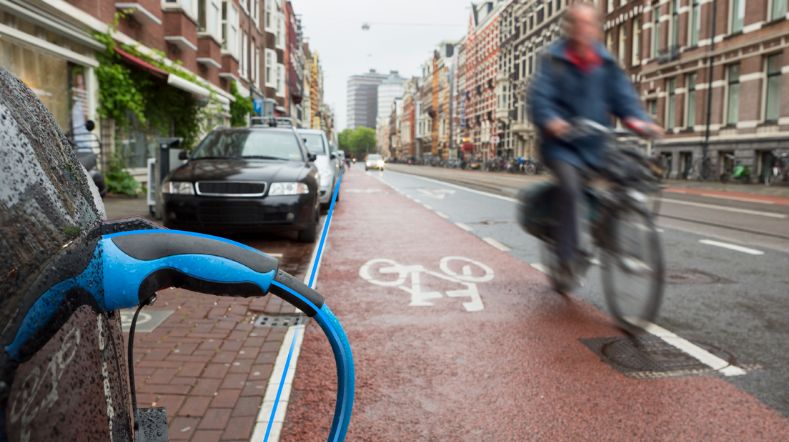
How governments can make MaaS work to societal goals
From the technology-driven, innovation-pushing and app-centric MaaS 1.0 we are now ready to enter the next phase by transforming it into Public Mobility. In the report ‘The Next Evolution of MaaS’, TNO emphasises the important role of governments in ensuring a future proof mobility system that contributes to societal goals.
In the late nineties, Mobility as a Service (MaaS) emerged as a buzzword in major cities worldwide, offering a solution to urban mobility challenges. This coincided with the global tech boom, leading to the rise of MaaS 1.0. Characterised as technology-driven, innovation-pushing, and app-centric, MaaS 1.0 saw significant involvement from big tech companies attracted by the prospect of substantial profits.
However, the hype surrounding Mobility as a Service quickly dissipated as providers entered and exited the market, leaving many cities disappointed with its failure to alleviate congestion or address environmental issues. So, what went wrong, and how can we ensure its successful implementation for societal benefits?

‘MaaS 1.0 was primarily business-focused and profit-driven.’
False promise: The app that could solve everything
To address these questions, Nico Larco, Marjolein Heezen, and Kevin Vedder of TNO collected insights from MaaS 1.0 and researched its success factors. ‘MaaS 1.0 was primarily business-focused and profit-driven,’ notes Nico Larco, Professor at the University of Oregon and Strategic Advisor at TNO.
‘While the goal was to change behaviour and contribute to the greater mobility system, the idea was that this was an easily profitable endeavour, and that therefore, governments just needed to interfere as little as possible with the market. The perceived problem was a technology issue, and the solution was as an app. We tend to imagine solutions and simplify them, and apps were trendy at the time. There was an expectation that this technology would function autonomously, but that wasn't the case at all.’
During the MaaS hype, numerous companies embraced platforms and apps, making grand promises that reality couldn't match. TNO researcher and consultant Marjolein Heezen explains, ‘There was a significant gap between the strategic goals that MaaS could contribute to and the reality that was operationalised and represented in the market. They overpromised, and underdelivered. Creating a functioning MaaS ecosystem was more complicated than people understood. This mismatch is the main reason why MaaS disappointed.’

‘Creating a functioning MaaS ecosystem was more complicated than people understood. This mismatch is the main reason why MaaS disappointed.’
Learnings from the success in Berlin
Some places have understood the complexities of creating the MaaS ecosystem and have seen more success. Kevin Vedder, a researcher and consultant at TNO, highlights cities like Vienna, Vancouver (still in the pilot phase), and Berlin as examples of effective deployment of shared mobility.
In Berlin, the Jelbi platform exemplifies the importance of collaboration between all stakeholders, both public and private, for success. Vedder notes, ‘It's interesting that one of the first hires for Jelbi was a relationship manager.’ Another critical success factor was the facilitation of physical infrastructure for mobility providers from the outset.
Nico Larco adds, ‘Moreover, Jelbi initiated this effort specifically to contribute to the societal goals of the transit agency and the city, understanding it would cost time and money to make that happen. This differs from a purely profit-driven approach often seen in the private sector.’

‘The term Public Mobility emphasises its added value for the general public. It urges governments to develop a healthy ecosystem where the public and private sectors work together.’
From MaaS to Public Mobility
The aimed transition from MaaS as a profit-driven app concept to a platform of public interest, is precisely why TNO prefers to use the term Public Mobility. According to Kevin Vedder, ‘The term emphasises its added value for the general public. It urges governments to develop a healthy ecosystem where the public and private sectors work together – a shared transportation system that addresses economic realities and challenges, with societal benefits as a primary driver.’
Marjolein Heezen adds, ‘Governments have relied too heavily on market parties with differing objectives. There's been a focus in policy on mitigating risks and avoiding nuisance from shared mobility concepts, rather than making them work for the public interests. We lack supportive or flanking policies, that for instance stimulate reducing the use and ownership of private cars, which is crucial for behavioural change towards a more sustainable and space-efficient mobility system. Flanking policies are necessary to encourage desired behaviour while navigating and addressing legacy systems.’

‘Shaping future mobility requires more than just additional infrastructure or, in the case of shared transportation, wheels on the ground. We need a system to facilitate a shift in behaviour.’
Governments in the lead
In the report (pdf) ‘Public Mobility: The Next Evolution of MaaS’ TNO asserts that governments stand to benefit greatly from a fully functioning Public Mobility System. Nico Larco explains, ‘The objectives of shared mobility align well with typical government goals for cities: reducing congestion and emissions, and improving liveability. There's a broader interest in making it work, and governments possess the power, capabilities, and relationships with various stakeholders to create the right conditions and supportive policies.’
Marjolein Heezen concurs, stating, ‘Cities face multiple challenges and transitions that profoundly affect urban space. Shaping future mobility requires more than just additional infrastructure or, in the case of shared transportation, wheels on the ground. We need a system to facilitate a shift in behaviour; otherwise, valuable investments may be wasted. Moreover, a digitally integrated mobility system provides valuable insights into the use of various transportation modes and tools to steer behaviour towards public goals.’ This holistic approach to mobility planning is essential for achieving sustainable and efficient urban transportation systems.

‘You need capacity dedicated specifically for Public Mobility. This requires dedicated staff, alignment, consistent funding, and support from top-level management.’
Success Public Mobility: Minimising barriers
To ensure the success of Public Mobility, a comprehensive ecosystem involving various stakeholders, both public and private, is crucial. Local authorities play a pivotal role in removing potential barriers. TNO has identified seven key focus areas to minimise these barriers, including developing clear guidelines on responsibilities, pricing mechanisms, and support, as well as constructing physical infrastructure.
Moreover, Nico Larco highlights an important lesson from successful MaaS cases: ‘You need capacity dedicated specifically for Public Mobility. This requires dedicated staff, alignment, consistent funding, and support from top-level management.’ Due to MaaS often being perceived as a technology matter limited to short-term pilot projects within IT or innovation departments, TNO notes that the adoption of shared mobility is impeded by insufficient support from higher levels of government.
Report ‘The Next Evolution of MaaS’
Creating regional competitiveness
Governments can also play a crucial role in creating attractive, competitive market conditions for both Transportation Service Providers (TSPs) and Mobility Service Providers (MSPs). Nico Larco explains, ‘These private stakeholders are typically multinationals that need to be convinced to deploy their shared mobility services in your city. Being part of a competitive global market means positioning yourself as an attractive and profitable location. With aligned goals, the right supportive policies, and ease of integration into the system, governments can make deployment more appealing.’
Marjolein Heezen suggests that, as a small country, the Netherlands should adopt a regional approach. ‘Having different regulations and systems for each city creates significant barriers to entry. Instead, cities can leverage (shared) established systems, contracts, and data standards to create a regional ecosystem.’ The TNO report identifies six ways (pdf) in which municipalities and regions can increase their competitiveness.
Threefold support by TNO
TNO offers threefold support to governments aiming to succeed with Public Mobility. Nico Larco explains, ‘Firstly, we aim to demonstrate the potential benefits and initiate strategic discussions, highlighting the relevance of shared transportation. Secondly, through an assessment of their current MaaS ecosystem, we provide specific insights and tools to enhance the situation.’
‘Thirdly, we help governments in establishing these ecosystems and provide assistance in developing the steering mechanisms and flanking policies to ensure the desired outcomes of implementation. Finally, I want to emphasise that governments don't have to do this alone. Leveraging existing research and lessons learned is key. We encourage building upon existing knowledge rather than reinventing the wheel.’
Download the report ‘The Next Evolution of MaaS’
Get inspired
Open call for European SMES and start-ups

Mobility transition


Case study analysis: Governance models for Mobility as a Service (MaaS)


